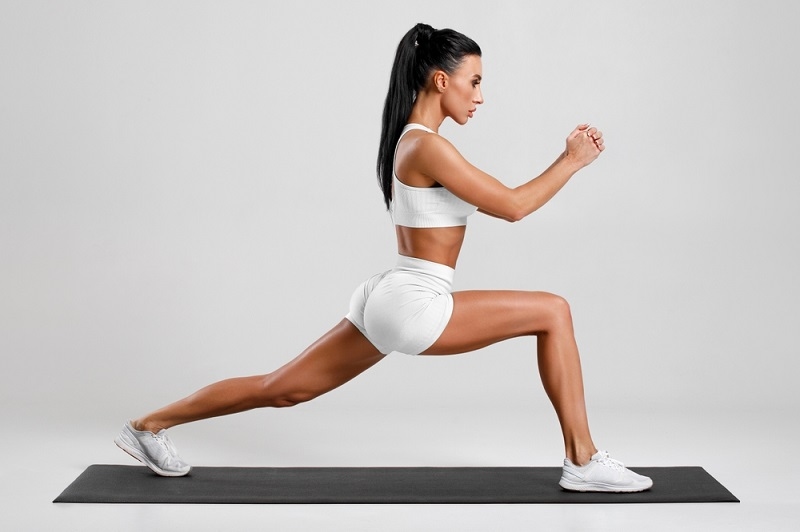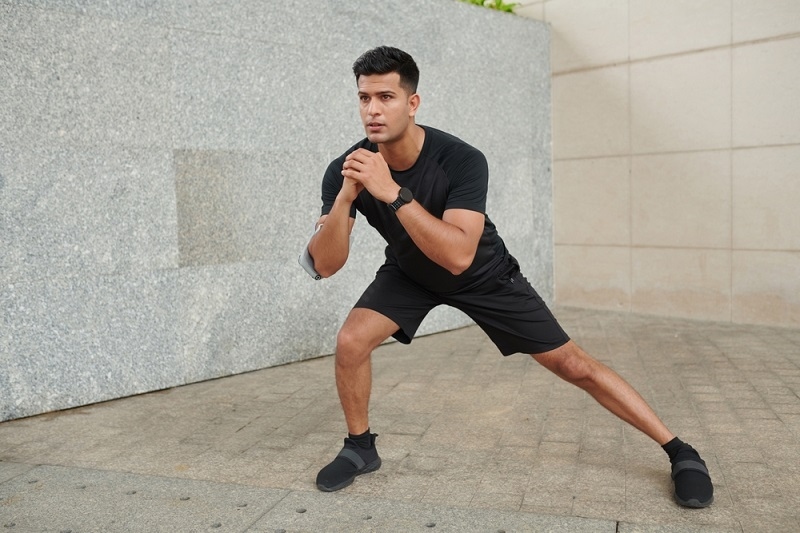
The lunges exercise is one of the most effective ways of increasing your lower body strength and improving your balance. It helps you increase the strength of your quadriceps, hamstrings, glutes, and calves while also improving stability and flexibility. Many people want to know how to do lunges correctly and how to do a proper lunge without putting stress on their knees. This simple guide explains the complete process along with safe variations like side lunges exercise, backwards lunges exercise, and lateral lunge exercise. By learning the correct form and understanding the lunge benefits, anyone can include this move in their routine confidently.
The lunge is more than just a leg exercise. It is a movement that mirrors everyday life. When you climb stairs, bend down to tie a shoe, or step forward to pick something off the floor, your body uses the same mechanics as a lunge. Training with lunges doesn’t just build strength—it makes daily tasks easier.
The benefits of lunges are visible in different muscles of your lower body. They are listed in the following points:
The front of your thighs helps you straighten your legs.
The back of your thighs that stabilize and support.
Your powerhouse muscles that drive you upward.
Stretched and strengthened as you move.
Holding balance and stability.
This is the reason trainers refer to lunges as a functional exercise. This exercise can train your body to move better in all situations.
Must Read: Try These Proven Tips to Boost Testosterone Naturally in Men

Once you have mastered the basic lunge exercise, there are endless ways to change it up. Each one shifts the focus just a little, hitting muscles from new angles. You can find the different variations in the following points:
Step forward into each rep and push back.
Keep stepping forward, almost like marching with purpose.
Step sideways instead of forward to hit inner thighs.
Step back instead of forward as it will put more stress on your knees and improve your body balance.
Place your back foot on a bench and load your front leg more.
Step one leg diagonally behind the other, like a bow.
Add dumbbells or a barbell for resistance.
Extend your arms forward as you step to challenge your balance.
Lunge down, hinge forward slightly, then rise.
These variations make sure you do not get bored, and your body doesn’t get too comfortable.
Not everyone can drop into a deep lunge right away, and that’s okay. There are ways to make it easier:
Hold onto a wall or chair for balance.
Only go halfway down instead of all the way.
Reduce the step distance for less strain.
Place your front foot on a small platform to limit motion.
If you are unsure how to do lunges properly, the following steps are exactly what you need:
Stand tall with your feet about hip-width apart, your shoulders relaxed and your core slightly tightened.
Step forward with one leg for about two to three feet and not just a small shuffle.
Bend both of your knees so that your front thigh should become almost parallel to the floor and your front knee moves right above your ankle.
Hold your chest up and do not lean forward or arch back. You have to stay steady in an upright posture.
Push through your front heel as you rise back to the starting position. You will be able to feel that your glutes and thighs are stressed with the workout.
These steps explain clearly how to do a proper lunge in real life that can improve your balance and lower body strength.
The number depends on your level:
Beginners: 1–2 sets of 10–12 reps per leg.
Intermediate: 2–3 sets of 12–16 reps.
Advanced: 3 or more sets, with added weights or harder variations.
You can alternate legs with each rep or complete all reps on one side before switching. Both work—it’s about preference.
Even a move this simple comes with its share of common slip-ups.
When the front knee shoots over the toes, it puts extra stress on the joint.
Some let the back knee twist inward or outward. Keep it pointing straight down.
A narrow stance makes it hard to balance and strains your knees.
Your spine should stay neutral and not curved.
Going too fast means you have a sloppy form and that is the reason you should do it slowly and steadily for best results.
Like all exercises, lunges are safe when done correctly, but a few notes matter:
If you have had issues before, check with a doctor or start with shorter, shallower lunges.
Especially in later months, stick to stationary lunges instead of walking ones.
Tight hips and quads can make lunges harder, so loosen them up beforehand.
Muscle burn is something that is common, but the sharp pain is not.
You should train with your bodyweight first and then later use weights for training.
Safety is not about being cautious and it is about making sure you can keep coming back tomorrow.
Lunges exercise is not the most stylish or glamorous. If you post a video doing lunges, the chances of going viral are less, but when you build them into your routine, they pay off in ways you will notice every day. Walking feels stronger, jumping feels easier, and your balance feels steadier.
So, the next time you step forward into a lunge, remember—you are not just working out. You’re training for life outside the gym. Stronger steps, steadier balance, better movement. All from one simple move.
The lunge is one of the most effective lower-body strength training exercises. Start with the basics, avoid common mistakes, progress into variations, and keep safety in mind. With consistency, lunges build strength, balance, and confidence in every step you take.
This content was created by AI